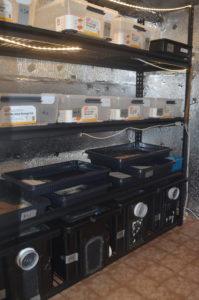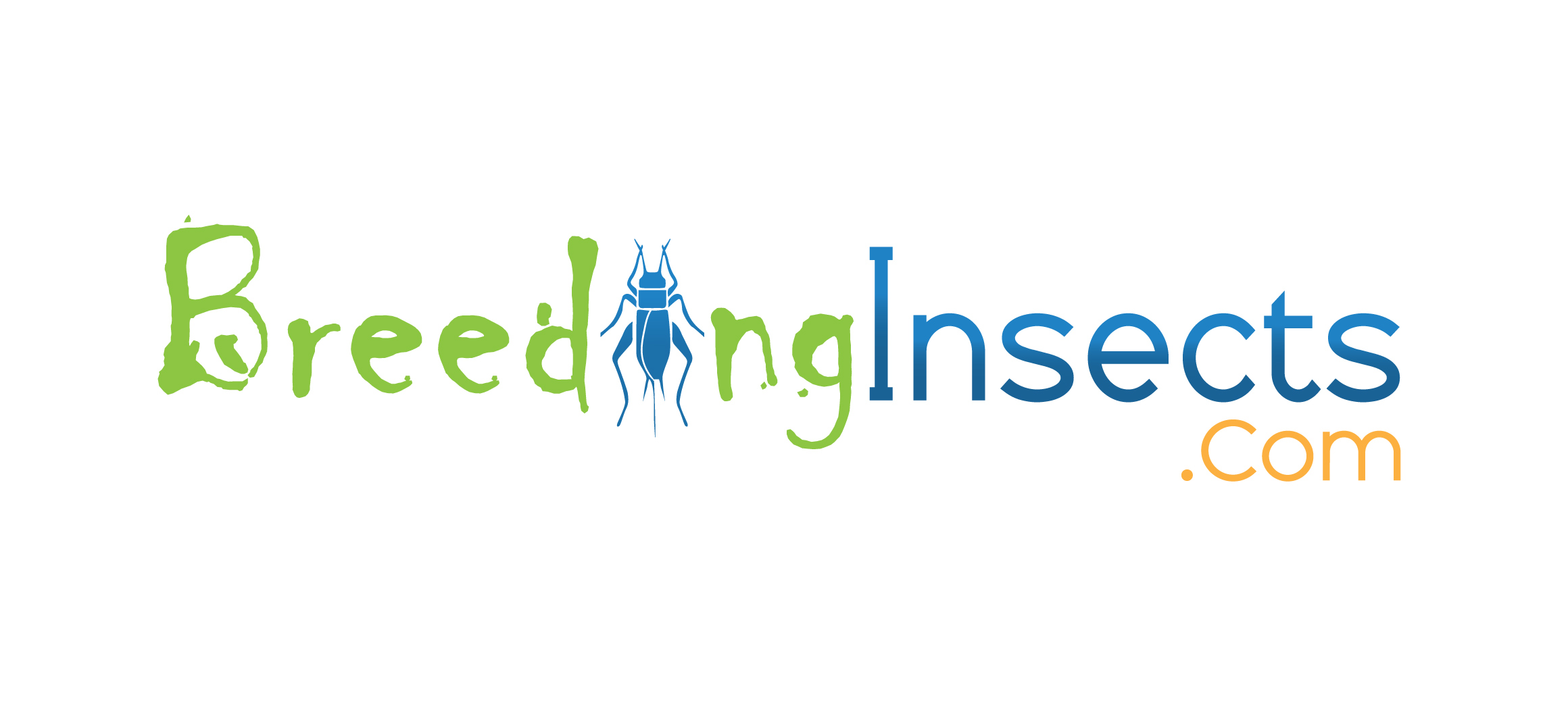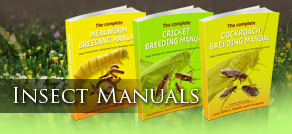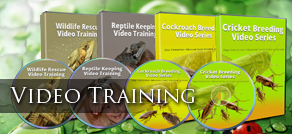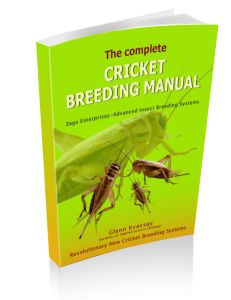
Lesson 1- Biology
Here is some info on Cricket Biology. Understanding the biology of crickets will help you solve many of the problems you may encounter. The above video gives you some other tips.
Crickets are insects that belong to the order Orthoptera, and family Gryllidae (true crickets). They are generally omnivorous, eating both vegetable and animal matter. Higher temperatures will decrease their life span but increase growth rate.
Our experience relates to breeding the common house cricket (Acheta domesticus) however all the methods we describe can just as easily be used for other species.
Life Cycle
A cricket will usually reach sexual maturity around 5-6 weeks depending on temperate and environmental conditions. The short life cycle of the cricket means that you must continually produce young crickets to maintain the colony. In summary the house cricket (the most common species kept) has the following life cycle:
- Male actively seeks the female, or attracts the female with a chirping sound made by rubbing the serrated edges of his fore wings (stridulation). Fast chirping is made when a threatening male approaches, and a slower chirping is made to entice a female to mate.
- Mating takes place and the male fertilizes female eggs. The female lays eggs approximately 1 cm into damp earth or organic material. When conditions are suitable the house cricket can lay eggs every second week throughout most of their adult life. Productive females can lay approximately 200 eggs in a batch. Eggs are whitish/yellow in color and around 2-3 mm long. A female cricket can produce approximately 600 or more eggs over her life time.
- Eggs hatch approximately 11-14 days later when bred at around 30 degrees Celsius (86 degrees Fahrenheit). The young are approximately 2-3 mm in length and are small replicates of their parents called pinheads or nymphs.
- As the crickets grow they need to shed their skin (molting) having a number of nymph stages. A cricket that has molted is white/yellow in color and is susceptible to being eaten until its exoskeleton (outer body casing) hardens (Refer to below photo-right).
- The young pinheads grow rapidly, shedding their skin regularly. The growth stages of a cricket are:
- Pinheads (2-3 mm long)
- Small crickets (up to 10 mm body length)
- Mediums (10 to 20 mm body length)
- Large (20-30 mm body length)

LEFT- Medium cricket on left, large cricket on right hand side.
RIGHT- Old exoskeleton on left, newly molted cricket on right
As shown above the distinction between medium and large crickets is when they obtain shiny wings and an ovipositor.
Temperatures
Crickets are exothermic (cold blooded) and are not able to raise their body temperature to optimize growth or movement. Commercial production systems maintain rapid growth rates by maintaining optimal environmental conditions, balanced nutrition and strict hygiene standards. This will prevent disease and pests from affecting the colony.
While they can survive a range of temperatures, they breed and grow best when temperatures are consistently between the range of 90-95 degrees Fahrenheit (30-35 degrees Celsius). Crickets are nocturnal in the wild, though in captivity they are active all times of the day and do not require lighting.
Behavior
In a commercial situation, hundreds of crickets are placed together in close proximity. This unnatural situation will result in either fighting or significant cannibalism unless their basic requirements are met. It is therefore essential that adequate food and water be available at all times combined with plenty of hiding spaces for animals to escape from each other. Young crickets and recently molted animals (yellow skin) are most vulnerable. Management and design options to reduce cannibalism are outlined in our manuals. Crickets are nocturnal in nature and do not require lighting.
Species Selection
Throughout the world a number of cricket species are bred commercially, however the most common three species are: 1) house cricket (Acheta domesticus or domestica in some publications); 2) Black cricket (Gryllus bimaculatus) and; 3) a new virus-resistant Jamaican Field Cricket (Gryllus assimilis).
House Cricket (Acheta domesticus)
The house cricket (Acheta domesticus or domestica in some publications) is the most popular species used in commercial production for most parts of the world. (Refer to photo). It is also commonly bred for human consumption. This is due to its great productivity and ability to handle a wide range of environments.
It is also known as the “European cricket” or “Brown house cricket”. The species is thought to have originated from South Western Asia; however it has spread to most countries around the world through the pet trade or accidentally in transport cargo. This species is given its common name due to its habit of living in houses to avoid cold winter temperatures. This species is typically grey or brown in color.

European house cricket, (Acheta domestica)
Productive females can lay approximately 200 eggs in a batch and are capable of laying a batch every couple of weeks. The house cricket is generally a hardy species that travels well when packaged appropriately and is well suited to commercial production. The information provided in this manual relates to experience gained with the breeding of the house cricket, which for the most part could be used for other species such as the black cricket.
Recently a virus known as the Cricket Paralysis Virus has spread from Europe to the US. The virus, only affects the Acheta domesticus (house cricket) and has caused cricket deaths across many commercial insect farms. Luckily this disease is safe to animals or humans.
Interestingly some of the large cricket farmers we speak with were unaffected and they had good hygiene and disease management methods. Unfortunately measures to contain this virus in other farms were largely ineffective and many cricket farmers switched to the virus-resistant Gryllus assimilis (Jamaican Field Cricket). The house cricket is still commonly bred across the world but in some parts of the US you may see more Jamaican field crickets being sold.
Black Cricket (Gryllus bimaculatus)
Another species commonly bred commercially throughout the world is the black cricket (Gryllus bimaculatus- refer to below photo). This species is also known as the “black field cricket” or “African/Mediterranean field cricket”. There are many species of black crickets and in some countries other closely related native species are bred. For example in Australia Teleogryllus commadus is occasionally bred. In the wild the young hatch in spring and feed on a wide range of seeds, plants, insect or animal products. This species color can range from jet black, brown or red depending on the species. Like the house cricket, they are omnivorous eating plant and animal remains.

Black field Cricket (Gryllus bimaculatus). Photo: Mitteleer Feldgrille
This species color can range from jet black, brown depending on the species. Like the house cricket, they are omnivorous eating plant and animal remains. The female can lay approximately 2, 000 eggs over their lifetime.
Species Comparison
Black crickets are slightly more sensitive during transit and are more demanding in their hygiene and husbandry requirements. They are slightly larger with a 3-4 cm body (1.18-1.57 in) and are generally more difficult to digest than the house cricket due to their chitinous (hard protective substance) thorax and wings. The house cricket is smaller with an approximate body size of 2-3 cm (0.79-1.18 in).
To reduce the impacts of introducing foreign species, consider using species native to your local area. Many countries have a native species of field cricket which are generally well suited to production. This is also a good strategy when your commercial supplier has insects showing signs of diseases or genetic inbreeding (deformities, low disease immunity etc.). As these species are from the wild, they generally have good genetic diversity. Although the risk of diseases is low, you may wish to have them in quarantine for a while to check that they do not harbor diseases or pests.
As you will initially need a local supplier and occasionally need additional stock to improve genetics, it is recommended to purchase the species which is easily obtained from other commercial breeders in your area.
Now that you know a little more about what makes crickets tick, in our next lesson we will look at how to breed them.
We have lots more to learn, however if you want to start breeding crickets today, then you can download the book and videos instantly at our “Products page” today.
Fast track cricket breeding with 14 Years experience and the Worlds most comprehensive cricket breeding book. Have a First Hand Look at the Book in This Video.
Have a First Hand Look at the Worlds most Comprehensive Cricket Breeding Guide
With around 160 pages and 240 color photos our insect breeding book series set the benchmark for insect breeding. To see why our book is the most comprehensive book you can buy on the topic, Click Here. We even include a video which walks you through the book so you have a first hand look.
Why not Turn an Expense Into Income?
For Information and advice on commercial production, Click Here. We have been breeding insects to Zoos, Wildlife carers, pet stores and the public for over 14 years.
We can show you how to build a profitable insect business. See below how you can follow our latest project converting a 20 foot caravan into a profitable insect business.
